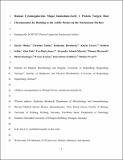Human cytomegalovirus major immediate early 1 protein targets host chromosomes by docking to the acidic pocket on the nucleosome surface
Abstract
The 72-kDa immediate early 1 (IE1) protein encoded by human cytomegalovirus (hCMV) is a nuclearly localized promiscuous regulator of viral and cellular transcription. IE1 has long been known to associate with host mitotic chromatin, yet the mechanisms underlying this interaction have not been specified. In this study, we identify the cellular chromosome receptor for IE1. We demonstrate that the viral protein targets human nucleosomes by directly binding to core histones in a nucleic acid-independent manner. IE1 exhibits two separable histone-interacting regions with differential binding specificities for H2A-H2B and H3-H4. The H2A-H2B binding region was mapped to an evolutionarily conserved 10-amino-acid motif within the chromatin-tethering domain (CTD) of IE1. Results from experimental approaches combined with molecular modeling indicate that the IE1 CTD adopts a β-hairpin structure, docking with the acidic pocket formed by H2A-H2B on the nucleosome surface. IE1 binds to the acidic pocket in a way similar to that of the latency-associated nuclear antigen (LANA) of the Kaposi's sarcoma-associated herpesvirus. Consequently, the IE1 and LANA CTDs compete for binding to nucleosome cores and chromatin. Our work elucidates in detail how a key viral regulator is anchored to human chromosomes and identifies the nucleosomal acidic pocket as a joint target of proteins from distantly related viruses. Based on the striking similarities between the IE1 and LANA CTDs and the fact that nucleosome targeting by IE1 is dispensable for productive replication even in "clinical" strains of hCMV, we speculate that the two viral proteins may serve analogous functions during latency of their respective viruses.
Citation
Mücke , K , Paulus , C , Bernhardt , K , Gerrer , K , Schön , K , Fink , A , Sauer , E-M , Asbach-Nitzsche , A , Harwardt , T , Kieninger , B , Kremer , W , Kalbitzer , H R & Nevels , M 2014 , ' Human cytomegalovirus major immediate early 1 protein targets host chromosomes by docking to the acidic pocket on the nucleosome surface ' , Journal of Virology , vol. 88 , no. 2 , pp. 1228-1248 . https://doi.org/10.1128/JVI.02606-13
Publication
Journal of Virology
Status
Peer reviewed
ISSN
0022-538XType
Journal article
Rights
© 2014, American Society for Microbiology. This work has been made available online in accordance with the publisher’s policies. This is the author created accepted version manuscript following peer review and as such may differ slightly from the final published version. The final published version of this work is available at https://doi.org/10.1128/JVI.02606-13
Collections
Items in the St Andrews Research Repository are protected by copyright, with all rights reserved, unless otherwise indicated.

